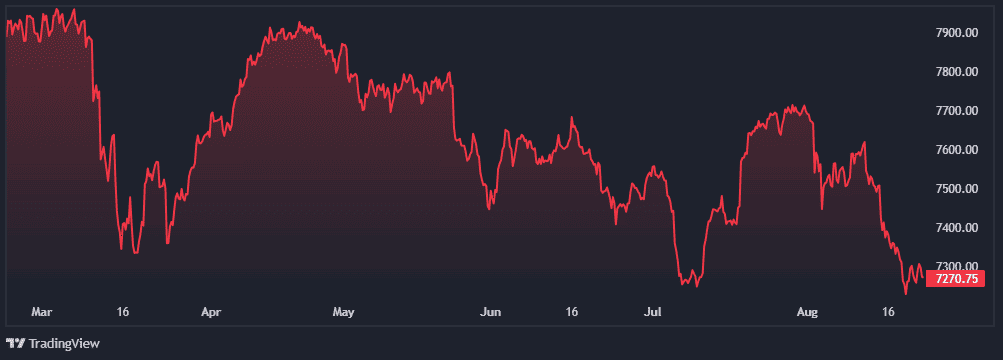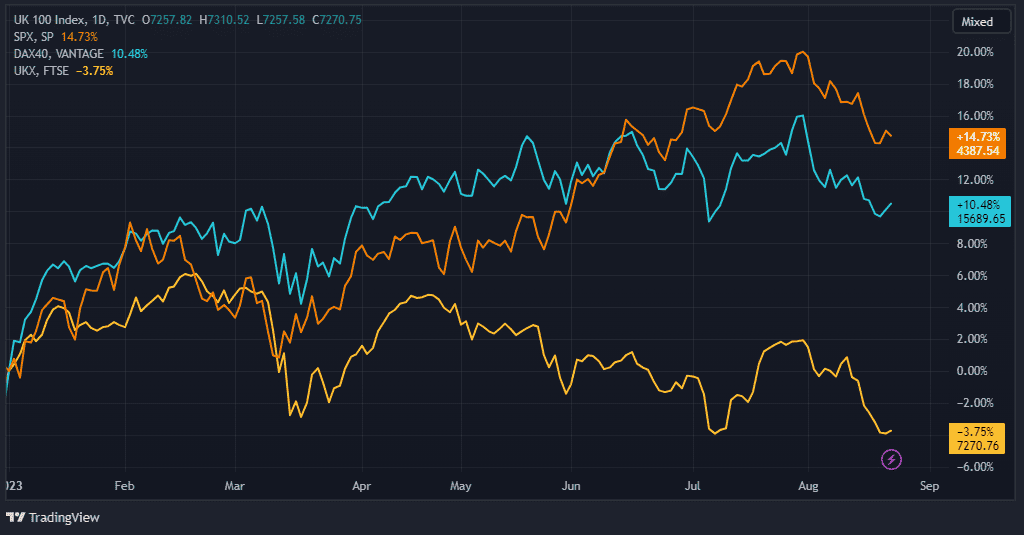
Should I buy the 2023 dip in FTSE 100 stocks? Here’s what the charts say

On 22 August, the FTSE 100 ended seven consecutive sessions of drops, its longest losing streak since mid-2019. But it only eked out a tiny 0.18% gain for the day and is still down 5.5% since the start of August. Year to date, the decline is even greater.
Is this dip worth buying? Here’s what the charts say.
A large six-month pullback

Above, we can see the index has fallen 8.3% in six months. Back then, it was at 7,952, which was not far off its all-time high of 8,014 points reached just a couple of days before.
Unfortunately, events soon took a turn for the worse when US lender Silicon Valley Bank (SVB) collapsed. This quickly impacted parts of the European financial system, resulting in Switzerland’s Credit Suisse being rescued. All this drama is visually represented by that initial sharp drop in the chart.
Once it became clear that UK financial firms weren’t overly exposed to this crisis, the FTSE 100 quickly recovered ground. However, since the end of April, it’s drifted downwards. In fact, the index is now lower than it was when it looked like another global banking crisis may have been unfolding.
On the surface, this doesn’t really make any sense. What’s worse now than the prospect of another financial meltdown? Nothing that I can see, so it’s a buy for me on that basis.
Lagging the competition
The FTSE 100 is an international index, with the constituent companies deriving approximately 75% of their revenues from overseas. The only other index with similar international exposure is the S&P 500, with roughly 40% of revenues generated outside of the US.
However, when it comes to performance, there is no comparison, especially in 2023.

Above, we can see the stark year-to-date underperformance of the FTSE 100 (-3.75%) compared to the S&P 500. However, the index is also lagging badly behind Germany’s DAX blue-chip stock market index.
Now, the S&P 500 outperformance I can understand, as this year’s rally has largely been driven by mega-cap stocks linked to artificial intelligence (AI). But, like the Footsie, the DAX isn’t full of AI stocks. It is heavily populated with financial, automotive and industrial companies.
Further, the German economy is already officially in a recession, while the UK is showing resilience (so far). Once again, I think FTSE 100 stocks are worth buying, especially from an income perspective.
| Dividend yield | |
| FTSE 100 | 3.9% |
| DAX | 2.6% |
| S&P 500 | 1.56% |
Valuation gap
This has left the FTSE 100 looking cheap compared to international counterparts. It trades at a P/E ratio of around 12. That’s less than half what we’re seeing over in the US.
However, cheapness isn’t a reason in itself to invest. There have to be realistic catalysts on the horizon to send the index higher. But are there any?
Well, actually I think there’s one: signs the tide is turning on high UK inflation and interest rates. If so, that would be a positive for the loan books of domestic-focused FTSE 100 banks, as well as the prospects for UK housebuilders.
That said, if the index does fall further in September, I’m prepared to invest in high-quality FTSE 100 companies at lower prices.
The post Should I buy the 2023 dip in FTSE 100 stocks? Here’s what the charts say appeared first on The Motley Fool UK.
Pound coins for sale — 51 pence?
This seems ridiculous, but we almost never see shares looking this cheap. Yet this recent ‘Best Buy Now’ has a price/book ratio of 0.51. In plain English, this means that investors effectively get in on a business that holds £1 of assets for every 51p they invest!
Of course, this is the stock market where money is always at risk — these valuations can change and there are no guarantees. But some risks are a LOT more interesting than others, and at The Motley Fool we believe this company is amongst them.
What’s more, it currently boasts a stellar dividend yield of around 8.5%, and right now it’s possible for investors to jump aboard at near-historic lows. Want to get the name for yourself?
See the full investment case
setButtonColorDefaults(“#5FA85D”, ‘background’, ‘#5FA85D’);
setButtonColorDefaults(“#43A24A”, ‘border-color’, ‘#43A24A’);
setButtonColorDefaults(“#FFFFFF”, ‘color’, ‘#FFFFFF’);
})()
More reading
- How I’d invest £3 a day in an ISA to get a second income of £37,957 for life
- 3 things that could make me buy RC365 shares right now
- RC365 share price crashes: it may have further to go! Here’s what the charts say
- I’d buy 10,000 shares of this growing penny stock to quadruple my money!
- Should I buy Glencore shares for a second income? Here’s what the charts say
Ben McPoland has no position in any of the shares mentioned. The Motley Fool UK has no position in any of the shares mentioned. Views expressed on the companies mentioned in this article are those of the writer and therefore may differ from the official recommendations we make in our subscription services such as Share Advisor, Hidden Winners and Pro. Here at The Motley Fool we believe that considering a diverse range of insights makes us better investors.




